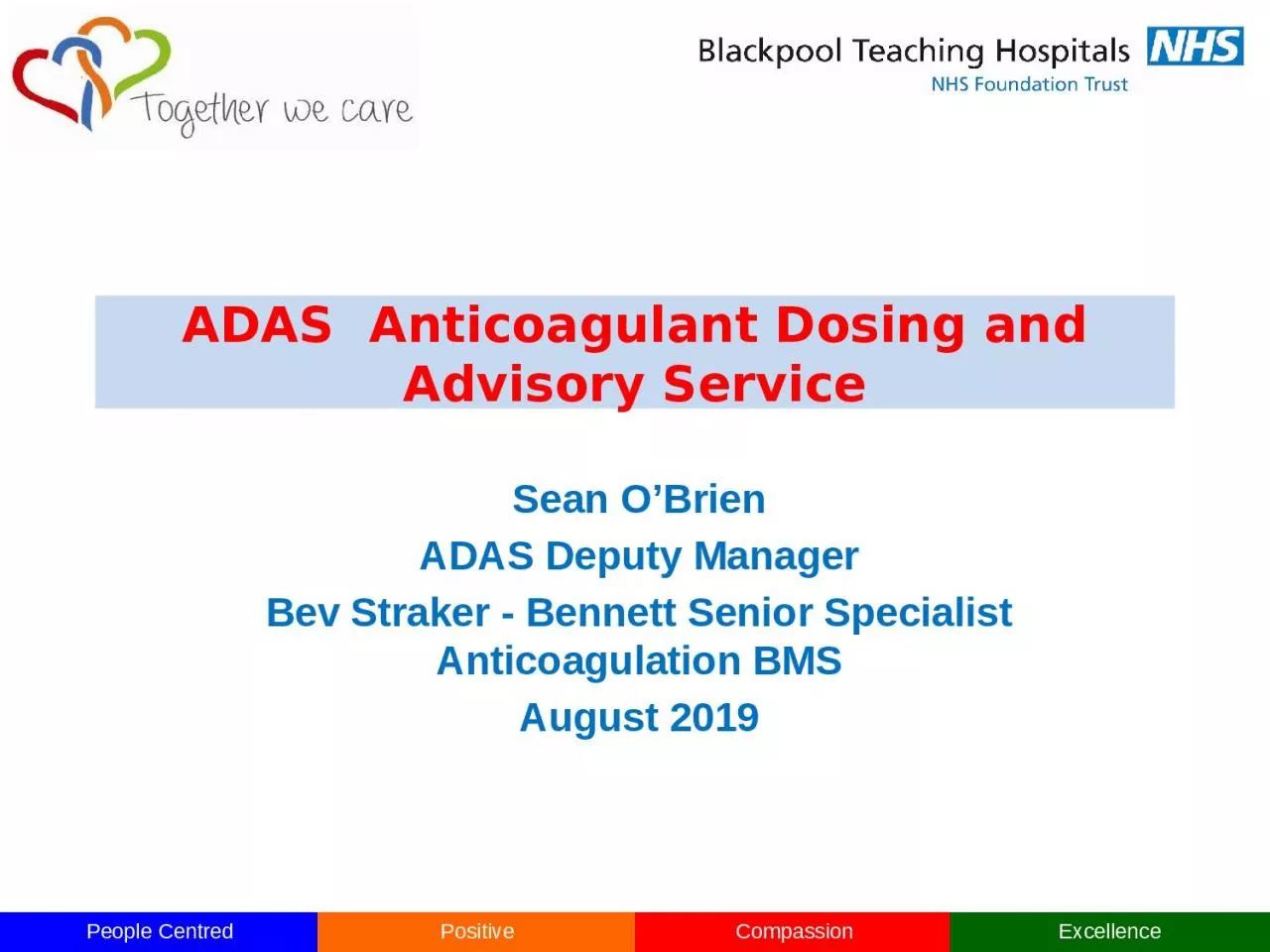

Sean OBrien ADAS Deputy Manager Bev Straker Bennett Senior Specialist Anticoagulation BMS August 2019 Service Provision ADAS is a Consultant led service managed by the Pathology Directorate ID: 931134
Download Presentation The PPT/PDF document "ADAS Anticoagulant Dosing and Advisory ..." is the property of its rightful owner. Permission is granted to download and print the materials on this web site for personal, non-commercial use only, and to display it on your personal computer provided you do not modify the materials and that you retain all copyright notices contained in the materials. By downloading content from our website, you accept the terms of this agreement.
Slide1
ADAS Anticoagulant Dosing and Advisory Service
Sean O’Brien
ADAS Deputy Manager
Bev
Straker - Bennett Senior Specialist Anticoagulation BMS
August 2019
Slide2Service ProvisionADAS is a Consultant led service managed by the Pathology Directorate.
Provides POCT and
computer assisted dosing advice to
6000 registered
patients on oral anticoagulant
therapy.
The
service is
delivered
by Biomedical
Scientists, Medical Laboratory Assistants.
All clinics are community based.
Daily housebound patient service.
Slide3Community Clinic sites
Slide4Warfarin dosing for intermediate care units.
Management of pre procedure INR levels
.
Management of pre procedure INR levels.
Direct links with DVT service.
M
anagement of patients awaiting cardiovascular procedures
Comprehensive Initiation / Education
for all new starters
. (WARFARIN / DOAC’s)
INR monitoring / warfarin dosing
DOAC safety checks / 3 week follow up
Slide5Anticoagulant service DOAC concernsVariation in initiation in both primary and secondary care.
Inconsistent education for patients.
Patients presenting
to
ADAS
clinics for advice and confused.
Patients prescribed a DOAC with contraindications.
Patients on both warfarin and a DOAC !Patient not on either anticoagulant !Switches done without renal bloods or INR checks. NICE guidance not followed.Switches done when INR is above recommended level (
bleeding risks).Patients on the wrong doses of DOACs / no follow up checks. Phone calls to ADAS for DOAC advice and switch assistance.
Slide6Scenarios
Patient
admitted to CAT unit at BVH as her INR was >10
.
D
ischarged
a day later with an INR of 7.3 following vitamin
K
ADAS had no update referral / no follow up check / no E discharge letter to GPADAS performed a home visit 3 days later INR still >3
Patient had been sent home and started on Apixaban on discharge with an INR of 7.3!! No follow up in place, no education for patient / carers.
Worrying Scenarios
Slide7Clinic patient attended confused about her anticoagulation. Started on rivaroxaban 3 days previously.
INR performed just
for safety and
a closing INR for
records
INR
was >8Patient previously on 3mg warfarin daily and had been
Rx’d 15mg rivaroxaban. She had taken 15mg of Warfarin and Rivaroxaban Oral Vit K administeredConsulted with GP re stopping and restarting Riva when INR<2She and her carer had not received any information the drug switch or counselling on DOAC
Worrying Scenarios
Slide8Patient requires Anticoagulation
Medics to discuss options with patient following trust guidelines and prescribe appropriate Anticoagulant.
NEXUS referral made to Adas. DOAC or Warfarin
Anticoagulation Initiated by Medic
Anticoagulation Initiated / switched by Adas
Education on chosen Anticoagulant. Safety Checks performed. Patient registered on centralised database
Warfarin
INR checked. Dosed amended/initiated. Follow up appointments in clinics arranged.
DOAC
Patient seen for three week follow up appointment to discuss issues/side effects
Discharged to GP care.All carers informed of medication changes if a switch of Anticoagulant has occurredRegular monitoring TTR/VGR review. Reports sent to GP
Secondary Care Pathway for all Anticoagulants
Slide9E Discharge Flag
Slide10Common DOAC issues
No clotting
screen at initiation (INR / PTT)
Liver enzymes not assessed or raised above safe limits according to product data sheets
Patient weight < 40kg or >120kg – no data on efficacy
Renal function not appropriate for DOAC use <15 ml/min Apix / Riva / Edox and <30ml/min Dabigatran
E GFR being used instead of Cock Croft Gault assessment for dosage, using actual body weight
Patients switched who are higher range 3-4 warfarin – APA / Clot whilst on warfarin / mechanical valve
Apixaban patients on 2.5 mg BD instead of 5 mg BD, using 1 instead of 2 of the dose reduction criteriaRivaroxaban prescribed at 20mg OD when Cr Cl 15-49ml/min
Slide11Common DOAC issues Patients not taking Rivaroxaban with largest meal
BD doses not taken at appropriate intervals
Renal function regular checks and care / action if renal function is declining
Reviews of dosage if patients weight or renal function or age indicate a change in dose
VTE patients - end of acute treatment duration review, discussions re prophylaxis or switch down to prophylactic dose for recurrent VTE
Confused / vulnerable patients - ? Risk with no
monitoring and switches should be carefully
implemented Switches to DOAC can be assisted by ADAS – checks to ensure safe INR levels / appropriate startsADAS switches back to warfarin closely monitored
Slide12Benefits of the pathway
Centralisation of all anticoagulant patients (universal anticoagulant database).
Auditable, consistent, comprehensive education for all patients/carers.
Less
M
edic time/confusion on who is educating patients.
Safe medication switches.
Secondary safety check to ensure: no contraindications (drugs or conditions) bloodwork is done and results appropriate correct dosage appropriate treatment duration3 week DOAC review Compliance for NRLS (NPSA) / NICE recommendations.